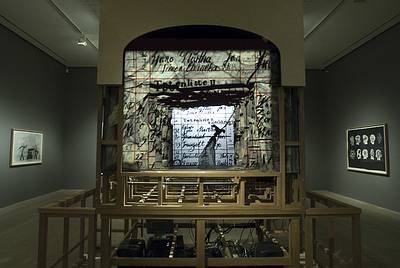
Amazing Black Box diorama, animation and robotic puppet extravaganza!
Yesterday was my day off from W—. Still trying to shake off some serious post-air travel all-round sluggishness, I hauled my carcass out onto the F line at Castro, which takes me basically to the door of SFMOMA, the Ferry Building and through the start of the Haight district. It’s a handy little tram (sorry, cable car) service.
I only know William Kentridge’s work from the Sydney Biennale last year- his installations in the top floor of one of the industrial buildings on Cockatoo Island were utterly magical, his combination of tromp l’oeil and digital technology ingenious and inspiring.
The show at SFMOMA was more of a “focus on” than a “retrospective”, and was divided into 5 themes apparently, but I tried not to pay too much attention to the didactic panels, so as to experience the work without too much chatter in the back of my head. I easily killed most of the day viewing the many films and installations on show, and will definitely drag B— along when he arrives so I can have a second go round.
In a testament to his variety as an artist, his paintings, charcoals, and prints were at least as strong as his better known animations, films, installations and dioramas (which were an absolute highlight).
Kentridge is South African, and this work seemed to date from the late 80’s, through the end of apartheid, up until work completed in the last 5 years. Given his background and the time frame, it’s not surprising that there is a high political content to his work, and his sometimes strident political messages are woven into otherwise rather sombre, romantic narratives by means of a range of recurring symbols. Some of these are familiar from early 20th century European art- the capitalist pig, the seething mass of humanity, the all-seeing kino eye- and some are more opaque and personal- cats, water and electrical power lines get a good showing. Beyond this political component, the works were compelling because of his strong use of narrative, and development of a suite of characters whose lives intertwine across the span of the work. These characters and their interactions are the bones of the films, and the politics is layered around them.
While I definitely admire his political message, and find it both impassioned and powerfully articulated, what I really love about his work is the way he has made much effort to re-create, re-imagine and re-birth some obsolete mediums, seamlessly mixing them with video and digital projection to achieve really captivating, moving works that delight as much as they challenge. On a basic level he does this to achieve an aesthetic that may be hard to manipulate in it’s original form. For example: many of the films are 16mm or 35mm transferred to video and then edited. At the more complex, and really interesting end of the scale, he has taken early and pre-cinema devices such as dioramas and painstaking mirror animorphosis, and hooked them up to computer controlled projection sequences and mechanical puppets.
These dioramas were spectacular and were a particularly vivid example of his interest in revealing the medium in the work. The set of the “Black Box” diorama was so elaborate and intricately layered, but all of it’s workings were completely exposed- raw wood scaffolding, the robotics controlling the puppets, the computers and dvd players piled beneath it. In his film work- his animated drawing and painting- this evidence of artifice is in the technique itself. Whenever there is movement across the screen, a shadow of each iteration is left behind, as well as eraser scrubbings, smudge marks and at times even finger prints. His figures wade through this murky world he has created for them, always leaving a mark of where they have been and what they have done.
Apart from revealing artifice, he also seems fascinated with progressions of movement, again drawing inspiration from an historical source- tableaux drawings, which showed movement or development across both space and time, bounded in the static image. Animation before animation existed. His procession sculptures, book collages, shadow puppet animations and drawings inspired by these tableaux were simple and yet infinitely compelling.
In fact, some of the most successful works were products of the simplest tricks, deployed artfully. A whole room was filled with wall-sized projections of funny, quirky films set in his studio where he has messed with the forward and reverse buttons – so the process of creation becomes a process of deletion, and then creation again. This is a trick as old as cinemas itself, and shouldn’t have the power to surprise or awe anyone born in the 20th century, but done in the context of the artist at work in his studio, where his existence and significance relies on his abilty to produce, it had surprising impact.
This show gave me plenty of food for thought, both intellectually and practically, and went some way to proving that the medium doesn’t make the work- the artist does!

Beautiful collage by William Kentridge

Hi jessie! Thanks for pointing me to the site. It’s cool! I saw a link earlier today to a big site on the same Kentridge show, with a selection of videos, and, for some odious reason, a bunch of wall texts transferred to the 1s and 0s. Hmm.
But Kentridge is unreal, yeah. I didn’t see his stuff at Sydney and was depressed for a month because of it! But hey, you should google a dude called Robin Rhodes (if you don’t already know of him). He works in the same vein and is absolutely brilliant.
Great- thanks for the tip…just eu-googled him and found this article:
Really interesting- goes into his process a bit. Seems like a funny guy too 🙂